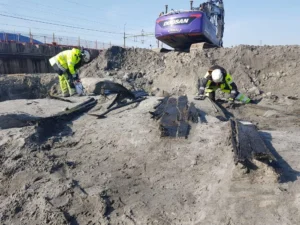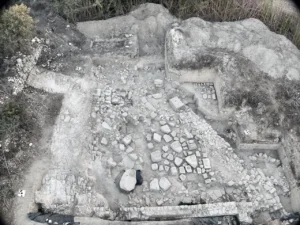Rajendra Chola’s Lost Lake to Return as Tamil Nadu’s Pride
On Rajendra Chola’s birth anniversary, Tamil Nadu begins reviving the 700-acre Chola Gangam lake, aiming to boost irrigation, ecology, tourism, and heritage pride.
What’s the story
Chola Gangam, once a grand reservoir built by King Rajendra Chola I, is getting a ₹19.25 crore revival as Tamil Nadu launches a restoration drive near Gangaikonda Cholapuram. Announced just ahead of the king’s birth anniversary on July 23, 2025, the plan includes repairing canals, boosting tourism, and building a museum. Once called the “liquid pillar of victory,” the lake was filled with Ganga water and supported irrigation and drinking needs over 700 acres. But today, it lies mostly dry. Experts hope the revival will recharge groundwater, restore agriculture on 1,374 acres, and attract birds and tourists alike. The lake is more than a waterbody—it’s a living symbol of Tamil Nadu’s engineering, environmental wisdom, and civilisational pride. Bringing it back is not just smart water management; it’s an emotional homecoming for a forgotten jewel of the Chola empire.
Heritage Power
Chola Gangam honoured a king’s victory with a lake of legends
When Rajendra Chola I returned victorious from the Ganges around 1025 CE, he didn’t just write history—he shaped geography. The king commissioned the excavation of Chola Gangam, an artificial tank near his capital Gangaikonda Cholapuram, to mark his northern conquest. Fed by water from the actual Ganga river, it earned the poetic title “liquid pillar of victory.” At its peak, the reservoir spanned 700 acres, supported irrigation for vast farmlands, and met drinking needs of the Chola capital. Historians like Nilakanta Sastri consider it one of India’s largest medieval reservoirs, with embankments stretching 16 miles and featuring complex flood control systems. For the Cholas, building a lake wasn’t just utility—it was glory set in stone and water. In today’s Tamil Nadu, this ancient reservoir still speaks volumes about the visionary water management of a king who ruled both land and legacy.
Brilliant Bunds
Stone-built banks reveal genius of Chola engineering minds
The tank’s elliptical bunds weren’t built randomly—they were carefully crafted with laterite stones, chosen for their resistance to water pressure. These 11th-century engineers added features modern planners would admire: sediment traps that cleaned the incoming water, silt ejectors that prevented clogging, and deep sluices that distributed water efficiently to fields. The tank was part of a larger hydraulic network, connecting the Kollidam river to Veeranam Lake, acting like a central water command hub. As reported in a 2023 Down To Earth article, Tamil Nadu’s ancient tanks are key examples of sustainable design, and Chola Gangam is perhaps the crown jewel. Imagine farmers over a thousand years ago planning for monsoons, silt, overflow, and water recycling—all with tools made of stone and mind power. That’s the kind of smart planning even today’s water-stressed cities dream about.
Quick Fact Box
-
Chola Gangam once spanned around 700 acres
-
Had a 16-mile-long embankment, among the longest in India
-
Named after the Ganga river, commemorating a royal conquest
-
Connected to Kollidam River and Veeranam Lake
-
Restoration cost: ₹19.25 crore, launched July 2025
Dying Giant
Dry lake and broken canals mark centuries of neglect
Fast forward a thousand years and the once-mighty Chola Gangam lies mostly forgotten. Seasonal rains are now its only lifeline, as its once-busy canals lie clogged or broken. The sluices—once marvels of engineering—are mostly defunct. A British-era bridge now stretches awkwardly across its dry belly, a ghostly reminder of both colonial touch and neglect. Groundwater in the surrounding region has dropped, and migratory birds have stopped visiting. A place that once buzzed with agriculture and life is now a quiet basin of lost potential. According to The Hindu’s June 2024 feature on Tamil Nadu’s tanks, over 60% of traditional water bodies in the state face similar decay. And yet, locals still remember stories their grandparents told about the lake’s fertile years—proof that the land is still listening, still waiting.
Green Revival
Govt’s ₹19.25 crore push aims to awaken the sleeping lake
In July 2025, the Tamil Nadu government launched an ambitious project to restore the lake in sync with Rajendra Chola’s birth anniversary. The focus is on three fronts: water infrastructure, tourism, and history. First, they’ll repair the tank’s banks and canals to bring water back into 1,374 acres of farmland. Then, they’ll add a heritage museum, visitor park, and security systems to make the site tourist-friendly. A 10-acre museum dedicated to the Chola king is also being built nearby. Officials say this could not only boost groundwater recharge but also revive bird migration patterns. According to Indian Express, state irrigation departments hope to bring back the lake’s original capacity within three years. For the locals, it’s not just about farming—it’s about pride. Reviving the lake feels like repairing a broken bond with the land and their legendary past.
Farmer’s Friend
Irrigation comeback could rescue 1,374 acres of farmland
Restoring Chola Gangam is expected to bring a much-needed lifeline to local farmers. Once restored, the tank could irrigate about 1,374 acres of surrounding farmland, most of which has gone dry due to groundwater depletion. Paddy fields, which once thrived due to this tank’s gentle, steady supply, may finally get a second chance. A 2022 report by the Tamil Nadu Agriculture University noted that over 45% of delta region farmers now rely on unpredictable borewells. This restoration could ease that pressure by bringing back surface water flow, improving soil moisture, and cutting down irrigation costs. For farmers like Ravi, who remembers his grandfather talking about how “the lake never let the village go hungry,” it’s not just infrastructure—it’s inheritance. If the tank can bring life back to even half that land, it will be a true harvest of hope.
Lost Birds
Migratory birds may soon return to their ancient pitstop
When the lake was full, hundreds of birds from as far as Central Asia and Siberia used to stop here during winter. With the tank lying empty and dry for years, the skies have been quiet. Restoration could change that. According to a 2023 Wetlands International report, Tamil Nadu’s lake restoration projects have led to a 30% increase in bird migration activity over 5 years. If Chola Gangam regains its waters, it could become a key pitstop on the East Asian–Australasian Flyway once again. Local birdwatchers say species like painted storks, spoonbills, and even flamingoes were once regular visitors. Bringing birds back would not just delight nature lovers but also help local ecology, as many of these birds feed on pests and control aquatic weeds. It’s not just a water tank—it’s a sky station waiting to reopen.
Smart Tourism
From dry tank to heritage hotspot with museums and parks
The government’s plan isn’t just about fixing old stones—it’s about telling stories. A new information centre and park are being built near the lake to help visitors understand the tank’s historical and ecological importance. Guided tours, 3D displays, and digital reconstructions of Rajendra Chola’s campaigns are expected. A 10-acre museum nearby will bring the Chola legacy to life for schoolchildren, tourists, and scholars alike. Inspired by successful models like the Hampi Heritage Park and the Rani ki Vav Light Show, Tamil Nadu hopes this mix of environment and storytelling can turn Gangaikonda Cholapuram into a must-visit destination. As The Hindu pointed out in April 2025, heritage tourism in South India has seen a 40% rise post-COVID, especially when sites are made visually engaging. For travellers, it’s not just a place to take selfies—it’s a lake with a 1,000-year-old soul.
People’s Pride
Lake once funded by locals may inspire new community action
Back in the Chola era, maintaining tanks like Chola Gangam wasn’t just the king’s job. Villagers contributed time, effort, and sometimes taxes to desilt tanks, repair bunds, and protect embankments. That culture of shared water responsibility turned tanks into symbols of both survival and self-reliance. The revival of Chola Gangam might bring that community spirit back. As seen in Telangana’s Mission Kakatiya, where over 27,000 tanks were revived with local help, water bodies thrive best when locals care. Panchayats and eco-clubs are now being roped in to help monitor the lake post-restoration. For youth groups, this could be a moment to learn that the past isn’t a relic—it’s a teacher. In Tamil culture, water is sacred. And Chola Gangam is the perfect reminder that every drop of heritage counts.
Final Glory
Revival of lake could become Tamil Nadu’s water model
The Chola Gangam revival isn’t just a one-off project—it could inspire a new template for water conservation across India. With over 5 lakh water bodies across the country in need of care, models like this show how history, engineering, ecology, and pride can work together. Tamil Nadu already leads in tank-based irrigation, but this restoration adds another layer—emotion. “A nation that forgets its rivers and lakes forgets its roots,” said environmentalist Dr. Jayakumar during the July launch. If successful, this project could push policymakers to look back to move forward. For schools, it’s a living classroom. For engineers, a masterclass in design. For villagers, a prayer answered. And for the rest of us? It’s a story of how even a dry lake can overflow—with purpose.
Key Takeaways:
- Chola Gangam was built by Rajendra Chola I to mark his victory over the north
- The 700-acre lake had one of India’s longest embankments (16 miles)
- Restoration will boost farming, tourism, groundwater, and ecology
- Tamil Nadu aims to use the revival as a model for other ancient tanks
- Community participation and education are key to long-term impact
So the next time it rains, look beyond the puddles. Somewhere in Tamil Nadu, a 1,000-year-old lake may be smiling back at the sky.
Also Read – Swapneswar Temple Gets ASI Protection
Share this content:















Post Comment